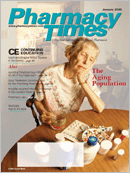Publication
Article
Pharmacy Times
Hospital-acquired Infectious Diseases in the Geriatric Patient
Author(s):
Hospital-acquired infectious diseasescan affect any personregardless of age, sex, or race.These diseases seem to impact the geriatricpopulation to a greater extent,whether because of increased risk factorsfor acquiring infections or becauseof inadequate host defense. Although theleading causes of death among the elderlyare chronic diseases—such as heartdisease, cancer, and stroke—infectiousdiseases remain among the top 10causes of death. According to theCenters for Disease Control and Prevention,pneumonia, influenza, and septicemiawere responsible for nearly96,000 deaths (5.5%) of people 65 yearsof age or older in 1997.1
Geriatric patients are at increased riskfor infections secondary to the age-relateddecline of the immune system, knownas immunosenescence. Comorbid conditionssuch as heart disease, diabetes, orchronic obstructive pulmonary diseaseoften can complicate infections, diminishingthe ability to treat them effectively.Frequent hospital visits and extendednursing care stays expose the elderly tohigher rates of infections.1 Malnutrition, amajor risk factor for infection, is estimatedto be present in 15% to 50% of elderlypatients who are admitted to the hospital.1 In addition, functional impairments—such as immobility, incontinence,or dysphagia—can enhancesusceptibility to infection by necessitatingthe use of invasive devices.2
Diagnosis of Infection
Diagnosing infection in elderly patientscan be challenging because they maynot display classic signs and symptoms.Fever and leukocytosis, 2 major indicatorsof infection, manifest less frequentlyor not at all in elderly patients due totheir body's inability to mount animmune response. These patients typicallypresent with changes in mental statusor a decline in cognitive function,which can be confused with dementia.Other indicators may be subtle or nonspecificcomplaints—such as falls, delirium,anorexia, or generalized weakness—that often delay care.1,3 Early diagnosisand treatment are critical because of thehigh morbidity and mortality associatedwith infections in this population.1
Common Hospital-acquiredInfections
Pneumonia is among the most seriousand frequent nosocomial infections inthe elderly. Aside from decreased immunefunction, anatomical changes inthe lung—such as diminished coughreflexes and mucus clearance—are likelyto contribute to the risk for pneumonia.Signs and symptoms are typically subtle,with bacterial causes identifiable in only20% to 50% of patients.4 Empirical pharmacotherapydirected at the most likelypathogens should be initiated in a timelymanner to minimize complications.
Urinary tract infections (UTIs) are themost common type of hospital-acquiredinfections, estimated to occur in 15% to30% of hospitalized elderly men and 25%to 50% of elderly women.3 Geriatricpatients are predisposed to developingUTIs due to the frequent use of Foleycatheters as well as anatomical changesin the urinary tract. Elderly men mayhave prostate enlargement leading toobstruction of urine flow, whereaswomen can have incomplete bladderemptying; both conditions provide agreat medium for bacterial growth or colonization.Upon clinical diagnosis, treatmentis based on the presence of symptoms.Asymptomatic bacteriurias do notnecessarily require treatment except incertain patient populations. Preventivemeasures are encouraged, however—such as minimizing catheter use, reducingduration of use, and changingcatheters routinely.4
Counseling the Elderly Patient
Three key areas should be addressedfor optimal management of hospital-acquiredinfectious diseases: infectioncontrol, vaccination, and patient education.Infection control is an importantcomponent in reducing the risk of nosocomialtransmission from patient topatient. Studies have shown that goodhand washing in combination with theuse of a virucidal foam or alcohol productcan reduce the infection rate by up to50%.2 All health care professionals andvisitors should wash their hands prior toand after patient contact. Patients withhighly resistant organisms should remainin isolation as required.
Primary prevention with vaccinationshould be encouraged in all geriatricpatients. Recommendations includeinfluenza vaccine annually and pneumococcalvaccine after age 65, unlesschronic conditions dictate administrationsooner.3 Revaccination for Pneumococcusshould be strongly considered forthose at highest risk. Family members orcaregivers for the elderly also shouldreceive influenza vaccination as a preventivemeasure.
On discharge from the hospital, thegeriatric patient should be educatedregarding drug-related matters, includingexpected adverse effects, the potentialfor drug interactions, and the importanceof compliance. A number of known age-relatedchanges affect the metabolism ofdrugs in the elderly. Adjusting medicationsbased on the patient's renal functionis important to minimize adverseeffects, which may be more frequent andsevere in the elderly population. This predispositionto adverse effects is relatedto the physiologic changes of aging, aswell as to chronic underlying illnesses,polypharmacy, and inappropriate dosingby prescribers.5
Unfortunately, few clinical trials havebeen designed to look at effects of drugsin this population.3 Therefore, it is importantto educate geriatric patients on thepotential for adverse reactions, as well asto screen for drug interactions. Patientsshould be counseled on the importanceof compliance to adequately eradicatethe infection. With appropriate drugselection, preventive measures, andpatient education, the health care communitycan attempt to decrease the incidenceof death caused by hospital-acquiredinfections in the elderly.
Dr. Cross is a transplant clinical pharmacistat Piedmont Hospital inAtlanta, Ga.
For a list of references, send astamped, self-addressed envelope to:References Department, Attn. A. Stahl,Pharmacy Times, 241 Forsgate Drive,Jamesburg, NJ 08831; or send an e-mailrequest to: astahl@ascendmedia.com.







